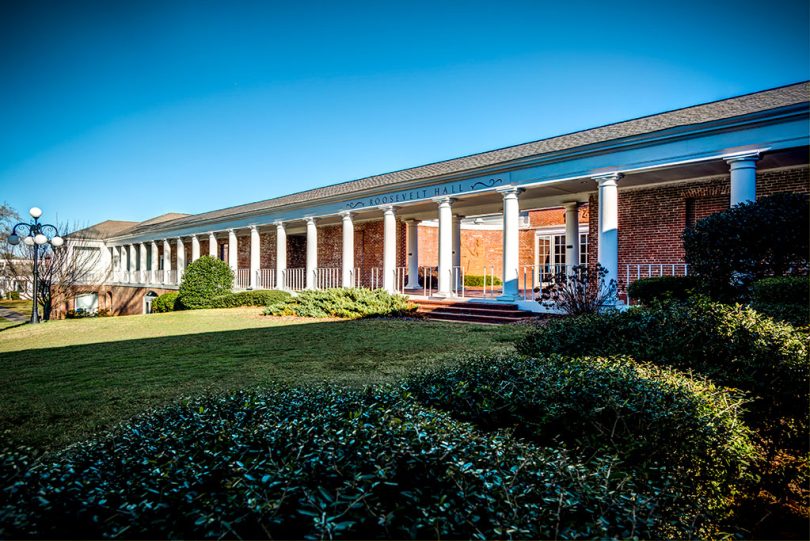A new telehealth partnership with Augusta University Health and Roosevelt Rehab and Long Term Acute Care has brought medical and acute care to patients while they’re undergoing rehabilitation. It’s all done through a specialized kit set up in the patient’s room.
This new partnership has allowed patients with serious injuries to receive treatment with AU Health doctors in a rural area. The program also decreases the costs for the patients and allows for consistent high-level care to patients.
Dr. Cassandre Perard is the Medical Director of the telehospitalist program at AU Health and has seen this program grow since its inception in the midst of the Covid-19 pandemic. She said what makes this in-patient telehealth program special is its ability to connect to patients to doctors going through intensive rehab, sometimes eight hours a day, without having to physically be in the patient’s room.
“A lot of the time rural hospitals struggle to care for patients and have to pay a premium for a hospitalist to care for their patient,” said Perard. “The niche we’ve found is, with the use of telemedicine, we are now able to care for these patients remotely without sacrificing the quality of the care.”
Roosevelt Rehab and LTAC specializes in caring for patients who have experienced life-altering events to their health that impact their physical function. Many have medical conditions that require medical management. The average length of stay in the rehab is 14 days. Through 14 months, the program has more than 4000 ‘encounters’ or telehealth visits, primarily in rehab.
This program – built from scratch by Perard along with Dr. Jackson Elam, CMO of Roosevelt Warm Springs, and Dr. David Walsh, AU Health Hospitalist Division Chief – is unique because there is no similar program implemented in the subacute setting in the state of Georgia.
Walsh said the lack of physicians across the state of Georgia creates a big hole for patient care. This problem is amplified the farther you travel from major medical centers in Augusta, Atlanta or Savannah.
“A lot of times we send patients to different rehab facilities, and we may lose contact with them,” said Walsh. “We don’t know what happens unless they, unfortunately, come back into the hospital. Now, we can provide care in the next phase through their recovery which is something that’s very new.”
The use of telehealth allows doctors to create a plan of care and address some of the issues with patients who have comorbidities or ailments with the help of the nurses in-house. Together, they can treat those patients without having to send them to an acute care hospital, which would interrupt their stay at the rehab and delay their recovery.
Some of these patients include Vontavious Howell and Roman Fox.
Both were involved in car crashes that changed their entire lives. Howell is recovering from surgery after a crash that fractured his left ankle, femur, fibula, and pelvis. Fox has had more than four surgeries after he fractured his neck and two of his vertebrae after a car crash back in August.
Howell and Fox were both taken to Warm Springs after their surgeries to begin extensive physical therapy. They’ve also worked with hospitalists at AU Health through the telehealth program, who have been monitoring both patients’ progress since they were brought into the hospital after their crashes.
Howell said he likes how convenient those visits can be. He knows these doctors have been with him since he was taken to AU Health, and said they’ve even been able to recommend some things he can do at the rehab center to control his pain levels. At the end of the day, Howell said the doctors just want to make sure he’s OK.
“It’s been a good experience, it’s just a little different because it’s my first time talking to a doctor through a screen, but I would recommend it,” said Howell.
Fox said he liked the program because of his doctors. He said the past two doctors have been able to push him on his recovery and show how other patients with his injuries have been able to recover.
“Going through something this dramatic, you kind of learn a lot about yourself,” said Fox. “They’ve been working me out pretty good, so far, and the calls with doctors aren’t really that different. It feels somewhat normal.”
Telehealth also allows nurses and staff at Warm Springs to assist under critical situations. Kathy Clark is the chief nursing officer of Roosevelt Warm Springs. She said the facility does not usually have emergency code situations in rehab, but when it does occur, the doctors can help out.
“The first time we had that happen was not too long after we started the program,” said Clark. “The nurses said it was wonderful and it felt like they had a doctor right there to help keep the patient stable enough to have them transferred out.”
The rehabilitation hospital is also thankful for a grant that allowed for the mobile cart the hospital uses for its telehealth appointments. This grant helped purchase the mobile cart they use, and the hope is to have monitors installed in each room. Perard said that will allow the physicians to dial in without having to move the cart from room to room.
“This grant will allow us to take the next step in the program,” says Perard. “I know this program will not work without building that trust [with nurses and staff]. They’re definitely our hands and eyes on the ground and it has been a real pleasure to work with them.”


